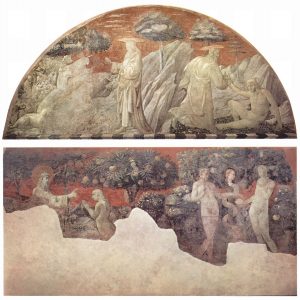Paolo Uccello was a Florentine painter whose work attempted uniquely to reconcile two distinct artistic styles: the essentially decorative late Gothic and the new heroic style of the early Renaissance.

Image source: https://it.wikipedia.org/wiki/
Uccello was probably born in Florence in 1397. His tax returns indicate that he was born in 1397, but in 1446 he claimed to have been born in 1396. His nickname Uccello derived from his passion for birds painting.
Early life and education

Image source: https://en.wikipedia.org/wiki/
At the age of 10, Paolo was an apprentice in the workshop of the sculptor Lorenzo Ghiberti, where many of the leading artists of the time were trained. In 1414 Uccello joined the confraternity of painters (Compagnia di San Luca), and the following year he joined the Arte dei Medici e degli Speziali, the official corporation of Florence to which the painters belonged. Although Uccello must have established himself as an independent painter, nothing remains of his work from this period.
How he became famous

Image source: https://it.wikipedia.org/wiki/Paolo_Uccello#/media/File:Paolo_Uccello_006.jpg
In 1424 Paolo was earning his living as a painter. As a demonstration of his artistic maturity, he painted episodes of the Creation and expulsion for the Green Cloister of Santa Maria Novella in Florence (now badly damaged). He was able to vividly paint a large number of animals. In contrast to many of his predecessors, he was able to paint trees in their natural colors, thus starting to acquire a reputation for landscape painting. The scenes of the Deluge, the story of Noah’s Ark, Noah’s sacrifice, and Noah’s drunkenness brought him great fame in Florence.
The years in Florence

Image source: https://it.wikipedia.org/wiki/Paolo_Uccello#/media/File:Paolo_Uccello_044.jpg
In 1432 the Office of Works asked the Florentine ambassador in Venice to inquire about Uccello’s reputation as an artist, who remained in Florence for most of his life, carrying out works for various churches and clients, including the Duomo. In 1436 he was entrusted with the commission for the monochromatic fresco of Sir John Hawkwood through which he showed his keen interest in perspective. The leader and his horse are presented as if the fresco was a sculpture, seen from below.
Studies on perspective

Image source: https://en.wikipedia.org/wiki/
Paolo Uccello tried to apply a scientific method to represent objects in three-dimensional space. Some of his studies on the perspective foreshortening of the bull are also preserved, and a standard demonstration of drawing skill has been his representation of the mazzocchio. In the words of G. C. Argan: “The rigor of Paolo is similar to the rigor of the Cubists at the beginning of the 20th century, whose images were more true when they were less true to life. Paolo constructs the space through perspective, and the historical event through the structure of the space; if the resulting image is unnatural and unrealistic, so much the worse for nature and history.” Perspective in his paintings has influenced many famous painters, including Piero della Francesca, Albrecht Dürer, and Leonardo da Vinci.
Info source:
https://www.britannica.com/biography/Paolo-Uccello https://it.wikipedia.org/wiki/Paolo_Uccello http://www.paolouccello.org/biography.html https://www.virtualuffizi.com/paolo-uccello.html
